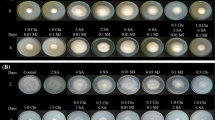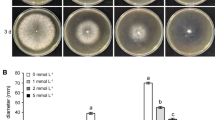Abstract
Postharvest anthracnose of mango fruit caused by Colletotrichum gloeosporioides is a devastating fungal disease, which causes tremendous quality deterioration and economic losses. Hinokitiol, an environmentally friendly natural compound, is effective in controlling a variety of postharvest fungal diseases. However, there is still a lack of research on the inhibitory effect of hinokitiol on C. gloeosporioides and its possible modes of action. In the present study, the activity of hinokitiol against C. gloeosporioides and its potential mechanisms involved have been investigated. We found that hinokitiol treatment could effectively inhibit the virulence of C. gloeosporioides to harvested mango fruit. After treatment with 8 mg/L hinokitiol, the mycelial growth of C. gloeosporioides was completely inhibited. When the concentration of hinokitiol reached 9 mg/L, the spore germination rate of C. gloeosporioides decreased to 2.43% after 9 h of cultivation. The inhibitory effect is mainly due to the attenuation in cell viability, and impairment in plasma membrane followed by leakage of cytoplasmic contents such as nucleic acids, proteins, and soluble carbohydrates, which ultimately leads to the destruction of cell structure. Furthermore, hinokitiol suppressed the expression of pathogenicity-related genes, leading to reduced infection activity. Collectively, these results suggest that hinokitiol may be an excellent bio-fungicides for the management of mango anthracnose.






Similar content being viewed by others
Data Availability
The data material is real, available, and transparent.
References
Alkan N, Friedlander G, Ment D, Prusky D, Fluhr R (2015) Simultaneous transcriptome analysis of Colletotrichum gloeosporioides and tomato fruit pathosystem reveals novel fungal pathogenicity and fruit defense strategies. New Phytol 205(2):801–815
Cerioni L, Volentini SI, Prado FE, Rapisarda VA, Rodriguez-Montelongo L (2010) Cellular damage induced by a sequential oxidative treatment on Penicillium Digitatum. J Appl Microbiol 109(4):1441–1449
Chaudhary PM, Tupe SG, Deshpande MV (2013) Chitin synthase inhibitors as antifungal agents. Mini-Rev Med Chem 13(2):222–236
Chen AW, Zeng GM, Chen GQ, Liu LL, Shang C, Hu XJ, Lu LH, Chen M, Zhou Y, Zhang QH (2014) Plasma membrane behavior, oxidative damage, and defense mechanism in Phanerochaete chrysosporium under cadmium stress. Process Biochem 49(4):589–598
Chiangsin R, Wanichkul K, Guest DI, Sangchote S (2016) Reduction of anthracnose on ripened mango fruits by chemicals, fruit bagging, and postharvest treatments. Australas Plant Path 45(6):629–635
Domon H, Hiyoshi T, Maekawa T, Yonezawa D, Tamura H, Kawabata S, Yanagihara K, Kimura O, Kunitomo E, Terao Y (2019) Antibacterial activity of hinokitiol against both antibiotic-resistant and -susceptible pathogenic bacteria that predominate in the oral cavity and upper airways. Microbiol Immunol 63(6):213–222
Gao XS, Wang QN, Feng QD, Zhang BB, He CZ, Luo HL, An B (2022) Heat shock transcription factor CgHSF1 is required for melanin biosynthesis, appressorium formation, and pathogenicity in Colletotrichum gloeosporioides. J Fungi (Basel) 8(2):175
Guo H, Qiao B, Ji X, Wang X, Zhu E (2020) Antifungal activity and possible mechanisms of submicron chitosan dispersions against Alteraria alternata. Postharvest Biol Tec 161:110883
He C, Zhang ZQ, Li BQ, Xu Y, Tian SP (2019) Effect of natamycin on Botrytis Cinerea and Penicillium expansum-postharvest pathogens of grape berries and jujube fruit. Postharvest Biol Tec 151:134–141
Ji D, Chen T, Ma D, Liu J, Xu Y, Tian S (2018) Inhibitory effects of methyl thujate on mycelial growth of Botrytis Cinerea and possible mechanisms. Postharvest Biol Tec 142:46–54
Jian YQ, Li Y, Tang GT, Zheng XJ, Khaskheli MI, Gong GS (2021) Identification of Colletotrichum species associated with anthracnose Disease of strawberry in Sichuan province, China. Plant Dis 105:3205–3036
Jin XY, Zhang M, Lu JH, Duan XM, Chen JY, Liu Y, Chang WQ, Lou HX (2021) Hinokitiol chelates intracellular iron to retard fungal growth by disturbing mitochondrial respiration. J Adv Res 34:65–77
Kim DJ, Lee MW, Choi JS, Lee SG, Park JY, Kim SW (2017) Inhibitory activity of hinokitiol against biofilm formation in fluconazoleresistant Candida species. PLoS ONE 12:e0171244
Kong WL, Rui L, Ni H, Wu XQ (2020) Antifungal effects of volatile organic compounds produced by Rahnella aquatilis JZ-GX1 against Colletotrichum gloeosporioides in Liriodendron chinense x tulipifera. Front Microbiol 11:1114
Lin S, Taylor NJ, Hand FP (2018) Identification and characterization of fungal pathogens causing fruit rot of deciduous holly. Plant Dis 102:2430–2445
Liu Q, Kong WL, Hu SJ, Kang YC, Zhang YT, Ng TB (2020a) Effects of Oudemansiella radicata polysaccharide on postharvest quality of oyster mushroom (Pleurotus Ostreatus) and its antifungal activity against Penicillium Digitatum. Postharvest Biol Tec 166:111207
Liu XY, Li JK, Cui XM, Ji DC, Xu Y, Chen T, Tian SP (2020b) Exogenous bamboo pyroligneous acid improves antioxidant capacity and primes defense responses of harvested apple fruit. LWT-Food Sci Technol 134:110191
Ma DY, Ji DC, Zhang ZQ, Li BQ, Qin GZ, Xu Y, Chen T, Tian SP (2019) Efficacy of rapamycin in modulating autophagic activity of Botrytis Cinerea for controlling gray mold. Postharvest Biol Tec 150:158–165
Meng FY, Liu X, Li C, Peng XD, Wang Q, Xu Q, Sui JL, Zhao GQ, Lin J (2023) Hinokitiol inhibits aspergillus fumigatus by interfering with the cell membrane and cell wall. Front Microbiol 14:1132042
Muller C, Staudacher V, Krauss J, Giera M, Bracher F (2013) A convenient cellular assay for the identification of the molecular target of ergosterol biosynthesis inhibitors and quantification of their effects on total ergosterol biosynthesis. Steroids 78(5):483–493
Ni YJ, Huang ZN, Li HY, Lee CC, Tyan YC, Yang MH, Pangilinan CR, Wu LH, Chiang YC, Lee CH (2022) Hinokitiol impedes Tumor drug resistance by suppressing protein kinase B/mammalian targets of rapamycin axis. J Cancer 13(6):1725–1733
Noar RD, Thomas E, Daub ME (2019) A novel polyketide synthase gene cluster in the plant pathogenic fungus pseudocercospora fijiensis. PLoS ONE 14(2):e0212229
Nosanchuk JD, Casadevall A (2006) Impact of melanin on microbial virulence and clinical resistance to antimicrobial compounds. Antimicrob Agents Chemother 50(11):3519–3528
Pereira EDJ, Panek AD, Eleutherio ECA (2003) Protection against oxidation during dehydration of yeast. Cell Stress Chaperon 8(2):120–124
Perumal AB, Sellamuthu PS, Nambiar RB, Sadiku ER (2016) Antifungal activity of five different essential oils in vapour phase for the control of Colletotrichum gloeosporioides and Lasiodiplodia theobromae in vitro and on mango. INT J Food Sci Tech 51(2):411–418
Qiao Y, Xu L, Xu G, Cao Y, Gao Y, Wang Y, Feng J (2022) Efficacy and potential mechanism of hinokitiol against postharvest anthracnose of banana caused by Colletotrichum musae. LWT-Food Sci Technol 161:113334
Rezende DC, Fialho MB, Brand SC, Blumer S, Pascholati SF (2015) Antimicrobial activity of volatile organic compounds and their effect on lipid peroxidation and electrolyte loss in Colletotrichum gloeosporioides and Colletotrichum Acutatum Mycelia. Afr J Microbiol Res 9(23):1527–1535
Shi XQ, Li BQ, Qin GZ, Tian SP (2012) Mechanism of antifungal action of borate against Colletotrichum gloeosporioides related to mitochondrial degradation in spores. Postharvest Biol Tec 67:138–143
Tang LH, Mo JY, Guo TX, Huang SP, Li QL, Ning P, Hsiang T (2020) In vitro antifungal activity of dimethyl trisulfide against Colletotrichum gloeosporioides from mango. World J Microbiol Biotechnol 36(1):4
Vanitha T, Thammawong M, Umehara H, Nakamura N, Shiina T (2019) Effect of hinokitiol impregnated sheets on shelf life and quality of KEK-1 tomatoes during storage. Packag Technol Sci 32(12):641–648
Wang WK, Lu MF, Kuan YD, Lee CH (2015) The treatment of mouse Colorectal cancer by oral delivery tumor-targeting Salmonella. Am J Cancer Res 5(7):2222–2228
Wang HQ, Fan K, Li DW, Han CM, Qu YY, Qi YK, Wu XQ (2020a) Identification, virulence and fungicide sensitivity of Colletotrichum gloeosporioides s.s. responsible for walnut anthracnose Disease in China. Plant Dis 104:1358–1368
Wang Y, Liu XY, Chen T, Xu Y, Tian SP (2020b) Antifungal effects of hinokitiol on development of Botrytis Cinerea in vitro and in vivo. Postharvest Biol Tec 159:111038
Wang CW, Duan TK, Shi LX, Zhang XQ, Fan WX, Wang MQ, Wang JM, Ren L, Zhao XJ, Wang Y (2022) Characterization of volatile organic compounds produced by Bacillus siamensis YJ15 and their antifungal activity against Botrytis Cinerea. Plant Dis 106(9):2321–2329
Wang YQ, Wu XX, Lu YQ, Fu HM, Liu SQ, Zhao J, Long CA (2023) Ferric chloride controls citrus anthracnose by inducing the autophagy activity of Colletotrichum gloeosporioides. J Fungi (Basel) 9(2):230
Wu Y, Cheng JH, Sun DW (2022) Subcellular damages of Colletotrichum asianum and inhibition of mango anthracnose by dielectric barrier discharge plasma. Food Chem 381:132197
Xu XB, Lei HH, Ma XY, Lai TF, Song HM, Shi XQ, Li JK (2017) Antifungal activity of 1-methylcyclopropene (1-MCP) against anthracnose (Colletotrichum gloeosporioides) in postharvest mango fruit and its possible mechanisms of action. Int J Food Microbiol 241:1–6
Xu HF, Wang GF, Zhang J, Zhang MJ, Fu MR, Xiang K, Zhang MY, Chen X (2022) Identification of phenolic compounds and active antifungal ingredients of walnut in response to anthracnose (Colletotrichum gloeosporioides). Postharvest Biol Tec 192:112019
Ye HC, Wang Q, Zhu FD, Feng G, Yan C, Zhang J (2020) Antifungal activity of alpha-mangostin against Colletotrichum gloeosporioides in vitro and in vivo. Molecules 25:22
Yong HY, Bakar FDA, Illias RM, Mahadi NM, Murad AMA (2013) Cgl-SLT2 is required for appressorium formation, sporulation and pathogenicity in Colletotrichum gloeosporioides. Braz J Microbiol 44(4):1241–1250
Zhao XZ, Tang BZ, Xu J, Wang N, Zhou ZS, Zhang JX (2020) A SET domain-containing protein involved in cell wall integrity signaling and peroxisome biogenesis is essential for appressorium formation and pathogenicity of Colletotrichum gloeosporioides. Fungal Genet Biol 145:103474
Acknowledgements
This work was supported by the grant from National Natural Science Foundation of China (32202565), Fujian Provincial Natural Science Foundation (2022J05151), and Initial Research Fund of Jimei University (ZQ2022011).
Funding
This research was funded by the grant from National Natural Science Foundation of China (32202565), Fujian Provincial Natural Science Foundation (2022J05151), and Initial Research Fund of Jimei University (ZQ2022011).
Author information
Authors and Affiliations
Contributions
Conceptualization: Shen Zhang, Ying Wang; Formal analysis: Jingyi Wang, Shen Zhang; Investigation and Data curation: Huimin Sun, Jing Yang, Jiajia Zhao; Methodology: Ying Wang; Supervision: Shen Zhang, Ying Wang; Writing-original draft: Shen Zhang, Huimin Sun; Writing-review and editing: Shen Zhang, Jingyi Wang, Huimin Sun, Ying Wang. Funding acquisition: Ying Wang. All authors reviewed the manuscript.
Corresponding author
Ethics declarations
Competing interests
The authors declare no competing interests.
Additional information
Publisher’s Note
Springer Nature remains neutral with regard to jurisdictional claims in published maps and institutional affiliations.
Electronic supplementary material
Below is the link to the electronic supplementary material.
Rights and permissions
Springer Nature or its licensor (e.g. a society or other partner) holds exclusive rights to this article under a publishing agreement with the author(s) or other rightsholder(s); author self-archiving of the accepted manuscript version of this article is solely governed by the terms of such publishing agreement and applicable law.
About this article
Cite this article
Zhang, S., Wang, J., Sun, H. et al. Inhibitory effects of hinokitiol on the development and pathogenicity of Colletotrichum gloeosporioides. World J Microbiol Biotechnol 39, 356 (2023). https://doi.org/10.1007/s11274-023-03810-1
Received:
Accepted:
Published:
DOI: https://doi.org/10.1007/s11274-023-03810-1




